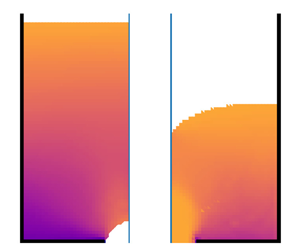Crossref Citations
This article has been cited by the following publications. This list is generated based on data provided by
Crossref.
Pongó, Tivadar
Fan, Bo
Hernández-Delfin, Dariel
Török, János
Stannarius, Ralf
Hidalgo, Raúl Cruz
and
Börzsönyi, Tamás
2022.
The role of the particle aspect ratio in the discharge of a narrow silo.
New Journal of Physics,
Vol. 24,
Issue. 10,
p.
103036.
Alborzi, Saeed
Abrahamyan, David
and
Hashmi, Sara M.
2023.
Mixing particle softness in a two-dimensional hopper: Particle rigidity and friction enable variable arch geometry to cause clogging.
Physical Review E,
Vol. 107,
Issue. 2,
Blatny, L.
Gray, J.M.N.T.
and
Gaume, J.
2024.
A critical stateμ(I)-rheology model for cohesive granular flows.
Journal of Fluid Mechanics,
Vol. 997,
Issue. ,
Li, Xingyue
Sovilla, Betty
Gray, John Mark Nicholas Timm
and
Gaume, Johan
2024.
Transient wave activity in snow avalanches is controlled by entrainment and topography.
Communications Earth & Environment,
Vol. 5,
Issue. 1,
Morales, Rodolfo
Vivanco-Avaria, Francisco J.
and
Palma, Sergio
2024.
A novel mathematical approach for gravity-driven granular flows in block caving.
Applied Mathematical Modelling,
Vol. 125,
Issue. ,
p.
756.
Fang, Wenchao
Chen, Sheng
Li, Shuiqing
and
Zuriguel, Iker
2024.
Clogging transition of granular flow in porous structures.
Physical Review Research,
Vol. 6,
Issue. 3,
Kamrin, Ken
Hill, Kimberly M.
Goldman, Daniel I.
and
Andrade, Jose E.
2024.
Advances in Modeling Dense Granular Media.
Annual Review of Fluid Mechanics,
Vol. 56,
Issue. 1,
p.
215.
Lu, Yimin
Jin, Wencheng
Klinger, Jordan
Saha, Nepu
Xia, Yidong
and
Dai, Sheng
2024.
Shear rate dependency on flowing granular biomass material.
Powder Technology,
Vol. 442,
Issue. ,
p.
119834.
Huang, Shuo
Wang, Xuefeng
Qu, Tongming
and
Liu, Caishan
2024.
Torque curve bifurcation in T-shaped rotor continuously drilling into granular media.
Powder Technology,
Vol. 444,
Issue. ,
p.
119947.
Taghizadeh, Kianoosh
Luding, Stefan
Basak, Rituparna
and
Kondic, Lou
2024.
Understanding slow compression of frictional granular particles by network analysis.
Soft Matter,
Vol. 20,
Issue. 32,
p.
6440.
Haver, Daan
Acuña, Daniel
Janbaz, Shahram
Lerner, Edan
Düring, Gustavo
and
Coulais, Corentin
2024.
Elasticity and rheology of auxetic granular metamaterials.
Proceedings of the National Academy of Sciences,
Vol. 121,
Issue. 14,
Chantharayukhonthorn, Maytee
Chen, Peter Yichen
Yue, Yonghao
Grinspun, Eitan
and
Kamrin, Ken
2025.
A hybrid discrete and continuum framework for multiscale modeling of granular media.
Computer Methods in Applied Mechanics and Engineering,
Vol. 441,
Issue. ,
p.
117936.
Amundson, Jason M.
Robel, Alexander A.
Burton, Justin C.
and
Nissanka, Kavinda
2025.
A quasi-one-dimensional ice mélange flow model based on continuum descriptions of granular materials.
The Cryosphere,
Vol. 19,
Issue. 1,
p.
19.
Wang, Yadong
and
Wu, Wei
2025.
A SPH Model Bridging Solid‐ and Fluid‐Like Behaviour in Granular Materials.
International Journal for Numerical and Analytical Methods in Geomechanics,
Vol. 49,
Issue. 2,
p.
738.
Feng, Hang
and
Yin, Zhen-Yu
2025.
Enhanced elastoplasticity-based frictional-collisional model for solid–fluid phase transition of granular media.
Computers and Geotechnics,
Vol. 183,
Issue. ,
p.
107218.
